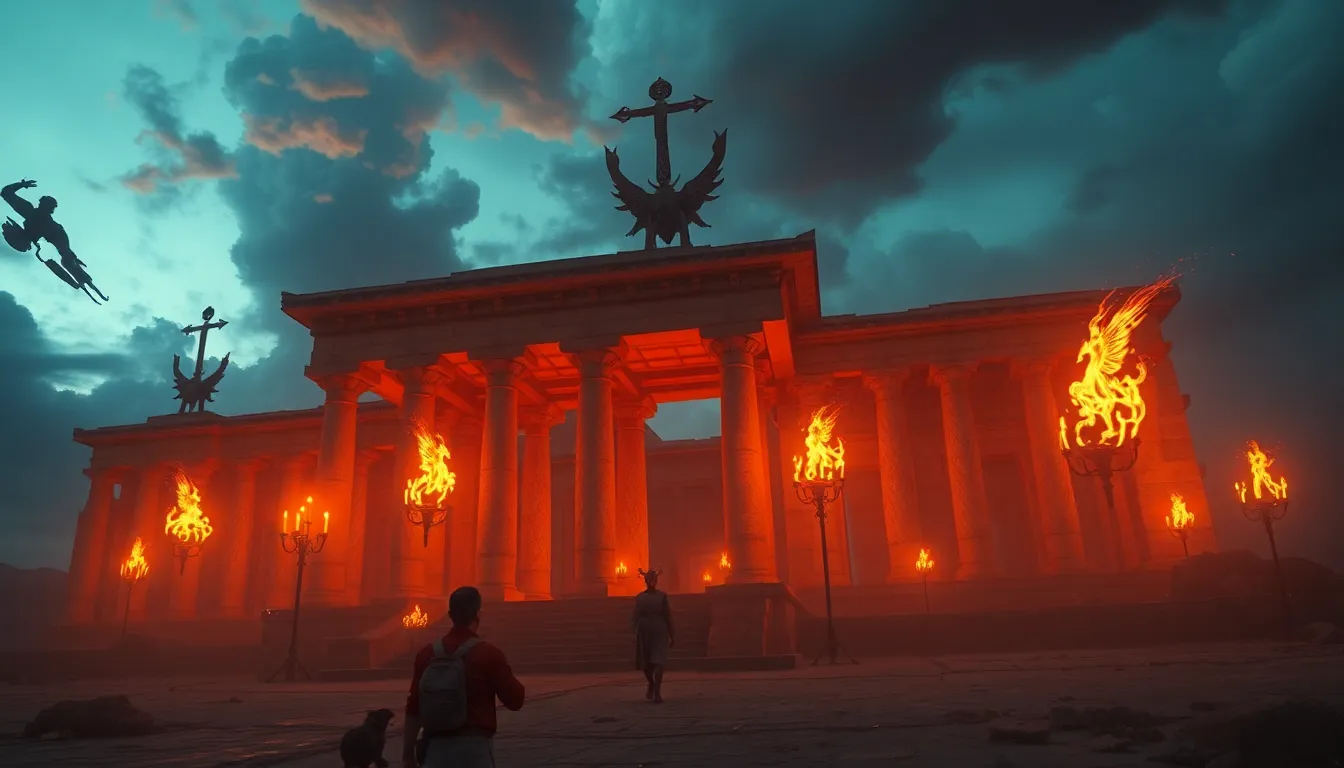The Flood Myths of the British Isles: Water in Celtic Lore
I. Introduction
Flood myths are a fascinating aspect of global cultures, often reflecting the relationship between humans and the natural world. In many traditions, these myths serve as allegories for moral lessons or as explanations for natural disasters. The British Isles, rich in Celtic mythology, present a unique tapestry of stories that revolve around water and flooding.
In Celtic mythology, water holds significant meaning, symbolizing life, death, and transformation. This article aims to explore the various flood myths of the British Isles, examining their origins, meanings, and relevance in contemporary culture.
II. Historical Context of Celtic Mythology
A. Origins and development of Celtic beliefs
The roots of Celtic mythology can be traced back to ancient tribes in Europe, particularly those in what is now Ireland, Scotland, Wales, and Brittany. Over centuries, these beliefs evolved through the intermingling of different tribes and influences from neighboring cultures.
B. The role of oral tradition in preserving myths
Oral tradition played a pivotal role in the preservation of Celtic myths. Stories were passed down through generations, often changing in detail but retaining core themes. This oral storytelling tradition helped maintain cultural identity in the face of invasions and societal changes.
C. Influence of geography and climate on Celtic narratives
The geography and climate of the British Isles influenced the narratives found in Celtic mythology. The frequent rains and lush landscapes shaped a worldview where water was both revered and feared, leading to the creation of flood myths that echoed these natural phenomena.
III. The Concept of Flooding in Celtic Lore
A. Symbolism and meanings of water in Celtic culture
Water in Celtic culture is multi-faceted, symbolizing purity, healing, and the flow of life. It is often associated with deities and spirits that govern rivers, lakes, and oceans.
B. The dual nature of water: life-giving and destructive
While water is essential for life, it also has the potential to cause devastation through floods. This duality is reflected in myths where water can bring both fertility and destruction, emphasizing the need for balance in nature.
C. Connection between floods and divine retribution
Many Celtic flood myths are tied to themes of divine retribution, where floods are seen as punishments for human transgressions. This connection highlights the moral undertones present in these stories.
IV. Major Flood Myths in the British Isles
A. The Deluge of Connacht: An Overview
The Deluge of Connacht is one of the most prominent flood myths in Irish tradition. According to the tale, the land was flooded as a result of the actions of the local king and his people, who angered the gods. The flood served as both punishment and a cleansing mechanism, allowing for a new beginning.
B. The Tale of Lugh and the Great Flood
This myth centers around the hero Lugh, who is associated with skill and craftsmanship. In this narrative, Lugh confronts a great flood that threatens the land. His journey to save his people serves as a testament to courage and ingenuity, highlighting the human spirit’s resilience in the face of natural disasters.
C. The Myth of the Tuatha Dé Danann and the Flood
The Tuatha Dé Danann, a race of divine beings in Irish mythology, also features in flood myths. Their conflicts with mortals often result in catastrophic floods, symbolizing the struggle between the divine and the mundane. These stories emphasize the consequences of ignoring the will of the gods.
V. Regional Variations of Flood Myths
A. Flood narratives in Irish mythology
Irish mythology is rich with flood stories, often depicting the land’s transformation following a deluge. These narratives frequently involve heroic figures who navigate the chaos and emerge as symbols of hope.
B. Scottish flood legends and their significance
In Scotland, flood legends often reflect the rugged landscape and the powerful forces of nature. Stories of floods are intertwined with local geography, such as the tales of Loch Ness and other bodies of water, emphasizing the relationship between myth and place.
C. Welsh flood stories and connections to landscape
Welsh flood myths are similarly linked to the landscape, often portraying floods as a means of shaping the land. These tales frequently involve local heroes and mythical creatures, showcasing the interplay between human and natural worlds.
VI. The Role of Deities and Spirits in Flood Myths
A. Key figures associated with floods: gods and goddesses
Many Celtic deities are associated with water and flooding, including Brigid, the goddess of fertility and healing, and the river god Lugh. These figures often embody the dual nature of water as both a source of life and a force of destruction.
B. The impact of water spirits and faerie lore
In addition to deities, water spirits and faeries play a significant role in flood myths. These entities are often depicted as guardians of rivers and lakes, with the power to control floods and bestow blessings or curses upon humans.
C. Comparative analysis with other mythological traditions
When compared to other mythological traditions, Celtic flood myths showcase unique characteristics, such as the emphasis on the land’s sacredness and the intertwining of natural elements with human narratives. This contrasts with more linear flood narratives found in other cultures, such as the Biblical account of Noah.
VII. Flood Myths and Environmental Reflections
A. Interpretation of floods as natural disasters
Celtic flood myths often reflect the understanding of floods as natural disasters, serving as warnings about the power of nature. These narratives encourage respect for the environment and recognition of its potential for destruction.
B. Historical accounts of actual floods in the British Isles
Throughout history, the British Isles have experienced numerous significant floods, which likely influenced the development of local myths. These events often resulted in community upheaval and transformation, reinforcing the themes found in mythology.
C. The interplay between myth and reality in Celtic narratives
The interplay between myth and reality is a crucial aspect of Celtic narratives. Flood myths often serve as allegories for real-life events, providing insight into how communities interpret and cope with natural disasters.
VIII. Modern Interpretations and Adaptations
A. How contemporary culture reinterprets flood myths
In contemporary culture, flood myths are often reinterpreted through various mediums, including literature, film, and art. These adaptations reflect modern concerns about climate change and environmental degradation, connecting ancient stories to present-day issues.
B. Influence of flood myths on literature and art
Flood myths have significantly influenced literary works and artistic expressions, inspiring writers and artists to explore themes of survival, transformation, and the human condition. The imagery of floods often serves as a metaphor for emotional and societal upheaval.
C. The role of folklore festivals and storytelling events
Folklore festivals and storytelling events continue to celebrate Celtic mythology, providing spaces for the preservation and performance of flood myths. These gatherings foster community bonds and encourage the sharing of cultural heritage.
IX. The Legacy of Flood Myths in Celtic Identity
A. Flood myths as a reflection of cultural identity
Flood myths are an integral part of Celtic identity, reflecting the values, fears, and hopes of the communities from which they originate. They serve as a means of connecting past experiences with contemporary life.
B. Preservation of myths in modern Celtic communities
Modern Celtic communities actively work to preserve their myths, ensuring that they continue to be passed down through generations. This preservation is vital for maintaining cultural heritage and identity.
C. The importance of folklore in understanding heritage
Folklore, including flood myths, plays a crucial role in understanding the heritage of the British Isles. These narratives offer insights into the beliefs, customs, and values of Celtic people, enriching the cultural landscape.
X. Conclusion
In summary, the flood myths of the British Isles present a rich tapestry of stories that explore the relationship between water, nature, and humanity. These narratives are deeply rooted in Celtic culture, reflecting the significance of water as a life-giving force and a powerful destroyer.
The enduring significance of flood myths in Celtic culture emphasizes the importance of understanding and appreciating these ancient stories. They not only provide insight into the past but also resonate with contemporary issues, urging us to reflect on our relationship with the natural world.
As we continue to explore and appreciate Celtic lore, we uncover the layers of meaning embedded within these myths, fostering a deeper connection to our shared heritage.



